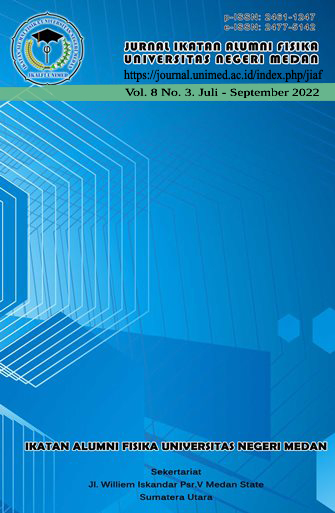Pemanfaatan Tes Konseptual Hukum Newton untuk Mapping Kompetensi Siswa SMA
DOI:
https://doi.org/10.24114/jiaf.v8i3.32694Keywords:
Pengembangan, Tes Pengetahuan Konseptual, Hukum Newton.Abstract
Penelitian ini bertujuan untuk mengembangkan tes Pengetahuan Konseptual untuk mengetahui kelayakan tes pada materi Hukum Newton. Jenis penelitian yang digunakan yaitu penelitian Research and Development (R&D) menggunakan model pengembangan ADDIE(Analysis, Design, Development, dan Evaluation). Instrumen Penelitian yang digunakan ialah angket validasi, tes, dan angket tanggapan siswa. Subjek penelitian ini yaitu siswa kelas XI MIPA yang berjumlah20 peserta didik pada uji skala terbatas dan 64 peserta didik pada uji skala luas. Dari analisis data, diperolehsebanyak 14 soal valid dengan koefisien reliabilitas sebesar 0,84.Tingkat kesukaran diperoleh sebanyak 6 soal mudah, dan 8 soal yang sedang. Daya pembeda diperoleh sebanyak 5 soal baik sekali, 8 soal baik, dan 1 soal cukup. Diperoleh sebanyak 13 butir soal memiliki efektivitas pengecoh sangat baik, 1 soal baik, serta tanggapan peserta didik terhadap instrumen tes yang dikembangkan sebesar 90,9% yang artinya instrumen yang dikembangkan sangat baik.This study aims to develop a Conceptual Knowledge test to determine the feasibility of the test on Newton's Law material. The type of research used is Research and Development (R&D) using the ADDIE development model (Analysis, Design, Development, and Evaluation). The research instrument used was a validation questionnaire, a test, and a student response questionnaire. The subjects of this study were students of class XI MIPA, totaling 20 students on the limited scale test and 64 students on the wide scale test. From the data analysis, obtained as many as 14 valid questions with a reliability coefficient of 0.84. The difficulty level was obtained as many as 6 easy questions, and 8 moderate questions. Distinguishing power was obtained as many as 5 very good questions, 8 good questions, and 1 sufficient question. It was obtained that 13 items had very good distractibility effectiveness, 1 item was good, and the students' responses to the developed test instrument were 90.9%, which means the instrument developed was very good.Downloads
Published
2023-05-16
Issue
Section
Articles
License
Copyright (c) 2023 JURNAL IKATAN ALUMNI FISIKA UNIVERSITAS NEGERI MEDAN

This work is licensed under a Creative Commons Attribution 4.0 International License.
Authors who publish with this journal agree to the following terms:- Authors retain copyright and grant the journal right of first publication with the work simultaneously licensed under a Creative Commons Attribution License that allows others to share the work with an acknowledgement of the work's authorship and initial publication in this journal.
- Authors are able to enter into separate, additional contractual arrangements for the non-exclusive distribution of the journal's published version of the work (e.g., post it to an institutional repository or publish it in a book), with an acknowledgement of its initial publication in this journal.
- Authors are permitted and encouraged to post their work online (e.g., in institutional repositories or on their website) prior to and during the submission process, as it can lead to productive exchanges, as well as earlier and greater citation of published work (See The Effect of Open Access).

